#1: Antenna's European journey to join Solar Orbiter
20 September 2018
On any spacecraft, the antennas are key pieces of hardware, being the all-important links with Earth. After several years of development, the main communications dish on ESA's Solar Orbiter is now ready to be integrated with the pioneering spacecraft.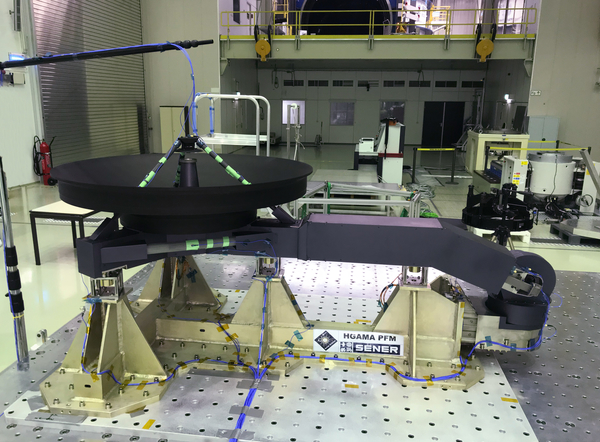 |
| Solar Orbiter High-Gain Antenna during vibration testing. Credit: SENER Aerospace / European Test Services |
Solar Orbiter is a space mission designed to examine how the Sun creates and controls the heliosphere – the vast bubble of charged particles blown by the solar wind into the interstellar medium – and for this reason will fly closer to our parent star than any mission has done so far [1]. It will also leave the ecliptic plane to provide the first-ever images of the polar regions of the Sun, which are key to understanding its magnetic variability, the so-called solar cycle.
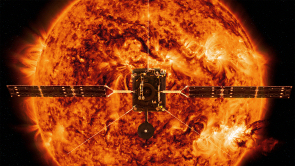 |
| Solar Orbiter. Credit: Spacecraft: ESA/ATG medialab; Sun: NASA/SDO/ P. Testa (CfA) |
Solar Orbiter's highly elliptical orbit will keep the spacecraft between 1.2 AU from the Sun at aphelion – equivalent to 180 million km – and 0.28 AU at perihelion – equivalent to 42 million km, well inside the orbit of Mercury.
In order to sustain communications with Earth, the spacecraft carries two low-gain antennas for near-Earth operations. However, during the three-year cruise toward the Sun, followed by its operational phase, the main communication links with Earth will be in the X-band frequency, using a steerable Medium-Gain Antenna (MGA) and a large High-Gain Antenna (HGA).
Solar Orbiter's High-Gain Antenna was designed with several objectives in mind. First, it must be able to operate in a unique, high-temperature environment.
Operating so close to the Sun, the spacecraft must endure 12 times the intensity of sunlight at Earth, resulting in external temperatures of 500 degrees Celsius or more. At the same time, all of Solar Orbiter's subsystems, including its communications subsystem, must be able to continue operating normally.
Not surprisingly, the design of the HGA, high-temperature technologies and materials were inherited and adapted from the main antenna that is being flown on ESA's BepiColombo, another mission to the innermost reaches of the Solar System. Scheduled for launch in October, BepiColombo will study Mercury, the least explored planet in the inner Solar System.
| High-Gain Antenna boom steering test. Click here for details and larger versions of the video. Credit: SENER Aerospace |
Whereas the antenna of BepiColombo is placed near the spacecraft structure of the Mercury Planetary Orbiter – one of the mission's three spacecraft – Solar Orbiter's HGA is located on the end of a 1-m long, movable boom. The boom can extend above or below the spacecraft's heat shield – which provides protection from the high levels of solar flux near perihelion – to achieve a reliable link with ground stations on Earth and transmit the huge volumes of data generated by the mission's scientific payload.
Besides the challenging thermal environment, the antenna must also be made of conducting material to avoid a build-up of electrostatic potential that would have a negative impact on the payload's capability to perform solar wind measurements.
To this aim, the 1.1-m diameter HGA reflector is made of titanium alloy, covered with a new type of high-temperature coating that is based on burnt-bone charcoal. Developed by Irish company EnBio, this Solar Black paint was chosen because it can maintain the same 'thermo-optical' properties even after years of exposure to unfiltered sunlight and ultraviolet radiation.
| High-Gain Antenna steering test. Click here for details and larger versions of the video. Credit: SENER Aerospace |
Due to the mission's unique orbit, the throughput of the data downlink is highly variable – from tens of bits per second up to 1 megabit per second. Most of the time, data will, therefore, initially be stored in Solar Orbiter's onboard memory before it is sent back to Earth at the earliest possible opportunity.
A testing journey across Europe
Much like the spacecraft, which after launch will use a series of gravity-assist manoeuvres, flying by Earth and Venus, to approach the Sun and reach its operational orbit, Solar Orbiter’s HGA has been travelling between Germany, Spain, the UK, France and the Netherlands over the past few years, completing all necessary tests before it is integrated on the satellite.
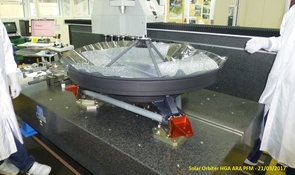 |
| Solar Orbiter Antenna Reflector Assembly. Credit: Airbus Defence and Space |
The story of the antenna began in 2014 at the premises of Afflerbach in Puderbach, Germany, where a 7-cm thick slab of titanium was heated to 940 degrees Celsius and then pressed in a mould to create a dome-like shape only 70 mm thick. This was then reduced to about 1 mm thickness in a milling machine operated by Ariane Group in Ottobrunn, Germany, where engines for the Ariane 5 rocket are made.
After that, it went to Airbus in Friedrichshafen, Germany, where it was assembled with the titanium frame, the carbide/silicon-carbide struts and the sub-reflector.
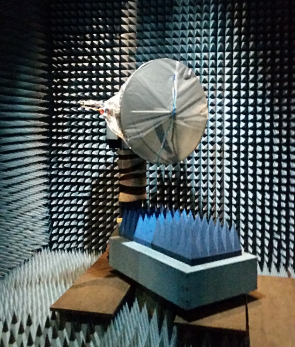 |
| Solar Orbiter High-Gain Antenna radio frequency testing. Credit: SENER Aerospace / Polytechnic University of Madrid |
In April 2017, it was subjected to mechanical vibration testing and then shipped to SENER – the antenna's prime contractor – in Bilbao, Spain, to be integrated with the rest of the HGA, including the radio frequency chain elements, the boom and the antenna pointing mechanism.
In May, the antenna performed the first radio frequency (RF) tests at Polytechnic University of Madrid, Spain, confirming that the required performances were met.
Then, the entire HGA was shipped to Reaction Engines in the UK to perform hot thermal cycling at temperatures up to 350 degrees Celsius.
The next step was to send the antenna to Intespace in Toulouse, France, to perform cold thermal cycling down to -160 degrees Celsius. In June, it was sent to ESA's technical centre in Noordwijk, the Netherlands, which is operated by European Test Service.
There, it performed a solar simulation test in a special sealed chamber, where it was exposed to an amount of solar light and heat comparable to the one it will experience during the mission. An acoustic (sound) test was also performed at ESA, and then the antenna was shipped back to SENER.
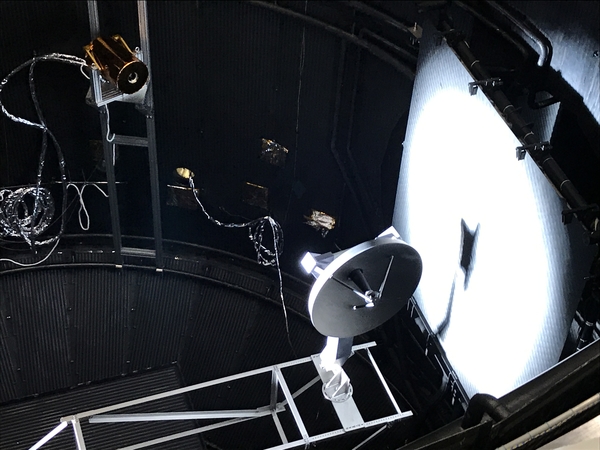 |
| Solar Orbiter High-Gain Antenna in ESA's Large Space Simulator. Credit: SENER Aerospace / European Test Services |
After a refurbishment at the end of 2017, the antenna returned to ESA's centre in the Netherlands in May 2018 to perform vibration testing. The following month, it was sent to the Polytechnic University of Madrid to perform the final RF tests, and then, back in Bilbao, a series of functional and deployment tests were performed.
Finally, with all the tests completed, the much travelled HGA was shipped in July to Airbus in Stevenage, UK, the mission's prime contractor, where the spacecraft integration takes place. Together with the almost fully integrated spacecraft, the antenna will be sent to IABG in Ottobrunn, Germany at the end of September, where it will join Solar Orbiter before the start of the satellite testing campaign.
Notes
[1] NASA's Parker Solar Probe, launched on 12 August 2018, will fly even closer to the Sun for short periods of time, gradually decreasing its perihelion distance over seven years down to 0.040 AU (6 million km) to explore the solar corona.
About Solar Orbiter
Solar Orbiter's mission is to perform unprecedented close-up observations of the Sun. Its unique orbit will allow scientists to study the Sun and its corona in much more detail than previously possible, and to observe specific features for longer periods than can ever be reached by any spacecraft circling the Earth. In addition, Solar Orbiter will measure the solar wind close to the Sun, in an almost pristine state, and provide high-resolution images of the uncharted polar regions of the Sun.
It will carry 10 state-of-the-art instruments. Remote sensing payloads will perform high-resolution imaging of the Sun's atmosphere – the corona – as well as the solar disk. Other instruments will measure the solar wind and the solar magnetic fields in the vicinity of the orbiter. This will give us unprecedented insight into how our parent star works, and how we can better predict periods of stormy space-weather that the Sun throws our way from time to time.
Scheduled for launch in February 2020, Solar Orbiter will take just under two years to reach its initial operational orbit, taking advantage of gravity-assist flybys of Earth and Venus, and will subsequently enter a highly elliptical orbit around the Sun.
Solar Orbiter is an ESA-led mission with strong NASA participation.







